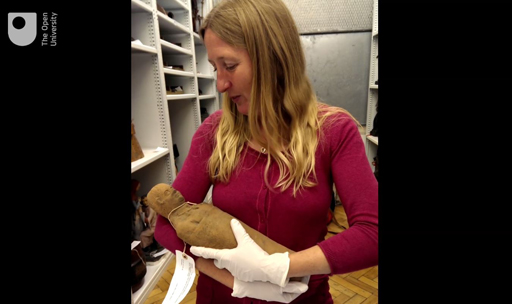2 The ideal body and the disabled body
This section explores attempts to mould the body to achieve the ideal physique, and how the disabled body was seen in society and art, particularly in relation to impaired mobility. Most people in the ancient world did not have a muscular physique. Nevertheless, from birth onwards attempts were made to ‘shape’ bodies into the ideal.
Watch the following short video in which you see Eleanor Betts of The Open University with an ancient votive offering made in the form of a swaddled baby.

After recording the video, Eleanor reflected:
Holding a newborn baby votive. Cradling it along one arm, its length matches my forearm, head cradled in the crook of my right elbow, feet resting in my right hand. I gently rock it. The weight is comparable to a new baby. But it is very cold to the touch because it’s kept in a [temperature controlled] cool storeroom. If it was in a sanctuary in Paestum, in the sunshine, the terracotta would be warm to the touch – blood temperature maybe? Feeling like the warm skin of a real baby? And if it was wrapped in swaddling bands it would be warm and soft and would smell of my own baby. Or maybe it doesn’t wear real swaddling bands because maybe it is apotropaic, a terracotta dissonant imitation of the baby I want so desperately. Am I trying to warm it up when I rock it? Or am I wistfully wishing it was my real baby? I feel a sense of attachment to it, an attachment which grows as I cradle and rock it. I don’t want to put it down. It is difficult to put it down.
You have read the views of Soranus, who wrote in the second century CE, about Men in the birthing chamber [Tip: hold Ctrl and click a link to open it in a new tab. (Hide tip)] ; Soranus also explained that swaddling and massage were two ways the baby’s body could be manipulated to encourage a healthy physical shape:
One must mould every part according to its natural shape, and if something has been twisted during the time of delivery, one must correct it and bring it into its natural shape … . The midwife should put the newborn down gently on her lap which has been covered entirely with wool or with a piece of cloth so that the infant may not cool down when laid bare while every part is swaddled. Then she must take soft woollen bandages which are clean and not too worn out, some of them three fingers in breadth, others four fingers … in order that the former may fit the limbs, the latter the thorax.
Swaddling clothes, according to Soranus, were made of wool because this was a breathable fabric. The wool was clean, warm and soft so that it did not injure the infant. A space could be left at the back for defaecation.
